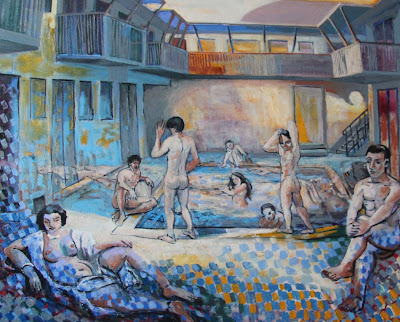Bathing at the Relais Samsara
 |
| Roy Forget, “Baignade au Relais Samsara,” 2018, Oil on linen, 81 x 100 cm |
Painting nudes in a landscape is perhaps one of the most common themes in art history, but for decades now, perhaps for over a half century or more, if figurative painting has come back and forth from curatorial oblivion, painting nudes in a landscape often seem fraught with the stigma of a certain retrograde sensibility. Contemporary taste may prefer perhaps something less loaded with the problematic history of the male gaze, the objectification of a woman’s body, and most importantly, the economics behind the fabrication of such idylls.
So, I painted nude bathers in a sort of landscape.
“Baignade au Relais Samsara” is deep into pastiche. It is so deep into quoting known precedents that it risks being nothing more than a series of quotations. But unlike artists who make art about art, this painting is not about art, not about the supposed canon of art anyway. It is not by intent slices of masterpieces by name-brand artists, from name-brand collections, arranged in a pleasant manner, to be enjoyed as a virtual museum of establishment aesthetics. It may risk doing so, but it did not intend to do so. It demands a bit more effort from the viewer, and if it does not transcend its origins, it is still its own, independent, warts and all.
There was once a swimming pool in the courtyard of an apartment building located on 389 North Los Robles Avenue, in Pasadena, California, that was the joy of the children who lived in the building. When the pool was open, during the warm weather months, they were allowed by the management to swim for 1 hour per day in the pool. Over time, however, the old swimming pool began to need more and more maintenance, there was a crack and a leak at the foundation, and the pump and filter broke down, and the building’s management decided that it would be more economically wise, given the exorbitant price of repair and maintenance, and more importantly, of replacing the pool’s foundation and the other equipment, to just fill it in with dirt and plant a sort of garden in the courtyard, put in a couple of palm trees, put in a bench, and call it a day. The swimming pool died and it was buried in dirt.
 |
| Photo taken in 2014, Courtyard of 389 N. Los Robles Avenue, Pasadena, California |
And so, the swimming pool of the courtyard ceased to exist as such and became a mere memory of those children who had once upon a time been the main beneficiaries of its embrace. But within that memory, bathers appeared. Not the mythological bathers, like Veronese’s Diana, bathing in her pond, spied on by Acteon, nor Poussin’s young men, swimming and fishing while Orpheus sings with his harp and Eurydice is stung by a serpent, nor Courbet’s voluptuous lesbians, sunbathing by the river.
The swimming pool that was once at 389 North Los Robles Avenue, in Pasadena, California, became inhabited by bathers of the late 19th early 20th century, who had Immigrated from France to the suburbs of Philadelphia, and then into the city itself.
They were bathers painted by Cézanne,
 |
| (Digital image/study of the ghostly takeover) |
They were bathers painted by Cézanne,
by Picasso,
by Matisse,
and Marthe, the obsessive bathing spouse of Bonnard, who joined the crowd from the Barnes Foundation, but all the way from across the state, in Pittsburgh:
Why they chose to inhabit this small swimming pool, one cannot know. Perhaps because it was simply now available for them to take residence in. And these itinerant phantoms, took over the pool in the courtyard of the Relais Samsara. And we may never know if these fine art ghosts are not the simple embodiments of the ghosts of more anonymous folk, like Mary Ryan, or John Smith.
The death of painting has been declared time and again by pundits. And it will likely be re-declared time and again. But if someone like Adrian Piper can publicly say that she believes in rebirth and reincarnation, then perhaps it isn’t so far-fetched to say that phantom bathers can enjoy themselves by the pool of the Relais Samsara, and this rebirth is as legitimate as any other human fantasy of eternity.






Comments
Post a Comment